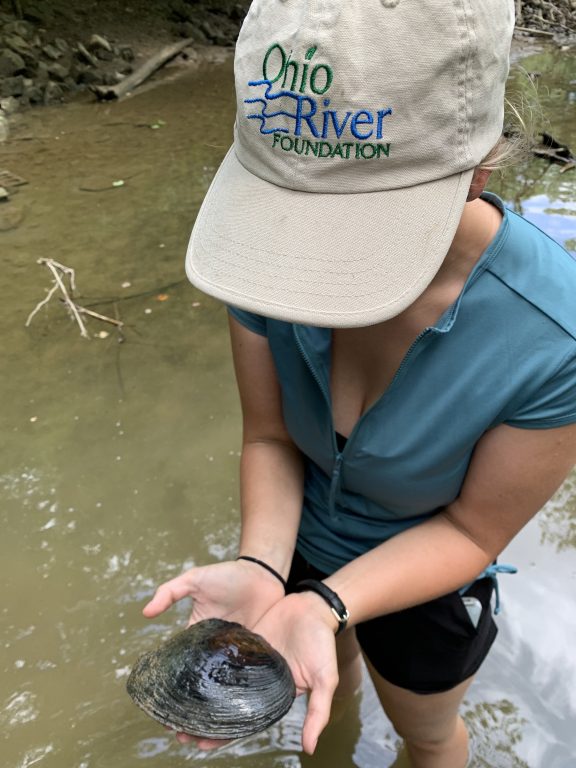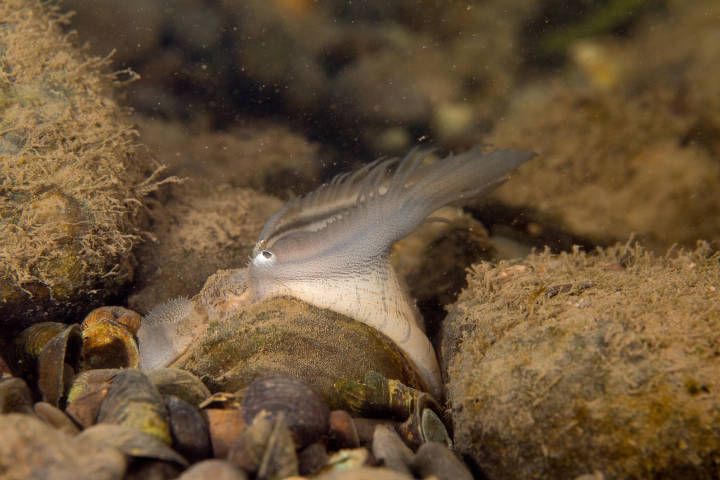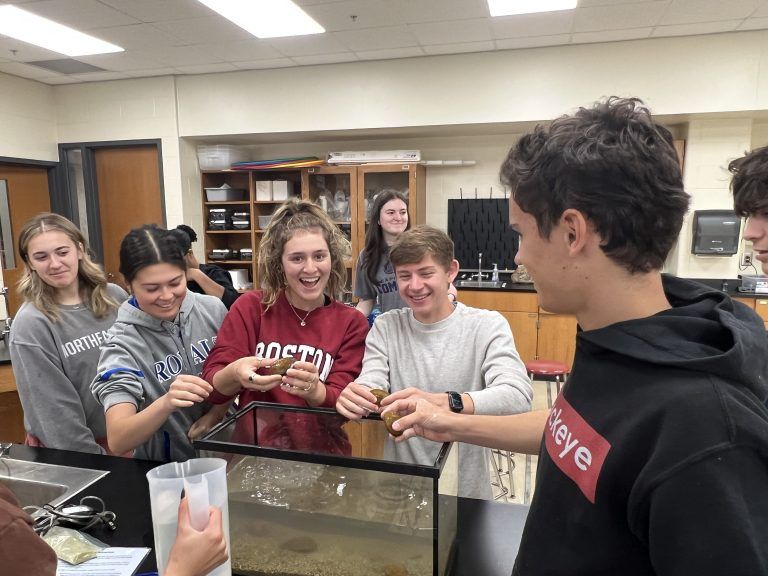Most people don’t know what a freshwater mussel is, much less consider them to be rockstars. More than likely if you’ve ever seen a mussel in the wild you’ve overlooked it as just another rock at the bottom of the stream. Mussels have us all fooled. Prepare to be amazed by these very outrageous creatures that share the Ohio River Watershed with us.
If you’ve waded around in rivers and streams you’ve probably seen fish busily darting around hunting for their next meal amongst mossy rocks. If you stopped and observed long enough you might see a fish stalking a smaller fish for lunch. This smaller fish has a pair of eyes, fins and is wiggling in the flowing waters near a rock, apparently unaware it’s about to be snatched up. But as the larger fish goes in for the kill and snaps at the small fish… blamo! The little fish disappears and out of what looks like a “rock” bursts a cloud of baby freshwater mussels right in the big fish’s face. What just happened?
Nature’s Best Disguise
Plain pocketbook mussel displaying lure, fish mimic with eye spot. Credit: Ryan Hagerty/USFWS
The large fish has just experienced the sneaky mimicry antics of a female freshwater mussel. Some species of freshwater mussels play dress up and put on a tantalizing show using a part of their body evolved to look like fish prey called a lure. They do this because mussels need a safe place for their baby mussels, or glochidia, to grow up. Mussels can’t get around very well with their false foot, or pseudopod, and they can’t provide a protective nursery space for their microscopic babies so they outsource the job — essentially they fool a fish into doing this for them.
When the fish is lured in close enough the female mussel releases a cloud of baby mussels which the fish sucks up into its gills, where those baby mussels clamp down and hold on for several months while they enjoy the oxygen, nutrients, and safety the fish unwittingly provides. Eventually, the baby mussels let go of the fish’s gills and fall to the bottom of the stream or river where they carry out the rest of their lives. So these wild mussels wear a gaudy costume and confidently put on a performance full of bravado and attitude.
Check out this video of a mussel exhibiting its lure and successfully tricking a bass.
Freshwater Filters
Mussels are so much more amazing than they initially appear, but would you guess they provide an essential service as well? Mussels are filter feeders, which means they take water, and everything in the water, into their bodies via a siphon. Mussels take in the aquatic algae they eat and also pollutants in the water. What comes out of the mussels’ outgoing siphon is super-filtered clean water. They are like Brita filters living in our waterways. They can filter 10-20 gallons of water a day removing harmful algae, bacteria and even metals.
If this seems insignificant consider this: the invasive Zebra mussel has unfortunately made its way into nearly every freshwater habitat around. Lake Erie’s invasive zebra mussel population can filter the entire volume of the lake in less than a month, making it 600% clearer. They have made the water so clear it’s harming native species because there isn’t enough left in the water for other native organisms to eat. Imagine what a healthy population of native freshwater mussels could do for the water quality and health of our local tributaries.
Saving our Biodiversity
Here in the Midwest, we are living in a mussel biodiversity hotspot for North America. Of the 297 species of mussels found in North America 127 were once found in the Ohio River Basin. Sadly today 70% of these species are extinct or endangered making freshwater mussels the most threatened organisms in North America. This is due to many factors but primarily habitat loss, pollution, invasive species (like the Zebra mussel and Asian clam), and overharvesting in the early 20th century for button production (freshwater mussels produce pearls just like their marine cousins, and their shells were prized for pearl buttons).
So what is to become of our favorite freshwater rockstars? The threats are real and daunting but there is a passionate community of biologists, hobbyists, volunteers, and organizations like Ohio River Foundation (ORF) determined to pull the remaining species back from the brink. ORF educates more than 5,000 students per year on watershed ecology and mussel conservation. ORF launched Mussels in the Classroom, the first program of its kind, in 2017. Through this program, students get the chance to play host to and learn about freshwater mussels and their importance to river ecosystems.
In addition to education programs, ORF dedicates countless hours to the restoration of Ohio River tributaries where mussels reside. ORF spearheads the removal of unnecessary dams that stop the critical flow of water, fish and mussel gametes. We also partner with organizations like the Center for Mollusk Conservation in Kentucky, which is responsible for the propagation and release of thousands of critically endangered mussel species back into Kentucky streams and rivers as well as important research and field surveys. Supporting organizations like ORF makes a difference for mussels!



